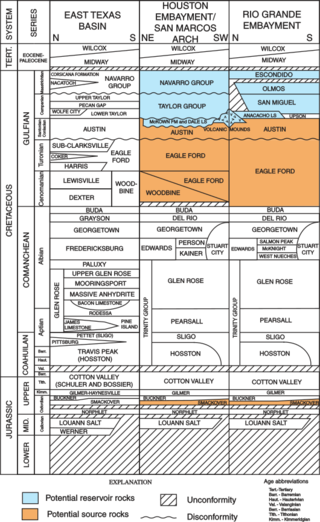| El Abra Formation | |
|---|---|
| Stratigraphic range: Albian | |
| Type | Formation |
| Location | |
| Region | San Luis Potosí |
| Country | Mexico |
The El Abra Formation is a geologic formation in Mexico. It preserves fossils dating back to the Cretaceous period. [1]
The Benevides Formation is a geologic formation in Texas and Mexico. It preserves fossils dating back to the Cretaceous period.
The Goodland Limestone or Goodland Formation is a geologic formation in Arkansas and Texas. It preserves fossils dating back to the Cretaceous period.
The Cintura Formation is a geologic formation in the northeastern Sonora of Arizona and Mexico. It preserves fossils dating back to the Cretaceous period.
The Rosario Group is a Late Cretaceous geologic group in southwestern California and northwestern Baja California (Mexico). In older literature it was named Rosario Formation.
The Ocozocoautla Formation is a geologic formation in Mexico. It preserves fossils dating back to the Cretaceous period.
The Taraises Formation is a geologic formation in northern Mexico. It preserves fossils dating back to the Early Cretaceous, including ammonites.
The Zapotitlan Formation is a geologic formation in Mexico. It preserves fossils dating back to the Cretaceous period.
The Agua Nueva Formation is a geologic formation in Mexico. It preserves fossils dating back to the upper part of the Cenomanian stage of the Cretaceous period. It consists "predominantly of alternating fossiliferous, organic matter-rich, laminated, dark gray limestone and non-laminated, organic matter-poor limestone in decimeter-thick beds with occasional centimetric beds of brown shale that show no apparent internal structures." The formation is noted for its qualities as a Konservat-Lagerstätte, with notable finds including the plesiosaur Mauriciosaurus and shark Aquilolamna.
The Cerro de Oro Formation is a geologic formation in Mexico. It preserves fossils dating back to the Cretaceous period.
The Boca Roja Formation is a geologic formation located at Huizachal Canyon in Tamaulipas, northeastern Mexico. The formation preserves fossils that were found in rocks dating back to the Cretaceous period. Another dinosaur-bearing formations is the Late Campanian El Gallo Formation. The Boca Roja Formation contains the oldest dinosaur remains found in Mexico.
The Cárdenas Formation is a geologic formation in Mexico. It preserves fossils dating back to the Cretaceous period.
The Clansayes Formation is a geologic formation in Mexico. It preserves fossils dating back to the Cretaceous period.

The Olmos Formation is a geologic formation in Mexico. It preserves fossils of plants, hadrosaurs, ceratopsians, tyrannosaurs and the turtle Palauchelys dating back to the Cretaceous period.
The Encino Formation is a geologic formation in Mexico. It preserves fossils dating back to the Cretaceous period.

The Georgetown Formation is a geologic formation in Mexico and the United States. It preserves fossils dating back to the Cretaceous period.
The Indidura Formation is a geologic formation in Mexico. It preserves fossils dating back to the Cretaceous period.
The Mal Paso Formation is a geologic formation in Mexico. It preserves fossils dating back to the Cretaceous period, Late Albian.
The La Caja Formation is a geologic formation in Mexico. It preserves fossils dating from the Kimmeridgian to the lower Berriasian. La Caja Formation is widespread in northeastern and central Mexico and known for their abundant and diverse well-preserved ammonites. It was deposited in hemipelagic conditions, and predominantly consists of siliclastic sediments, including marl, with limestone. It is laterally equivalent to the La Casita Formation, which represent more proximal facies. The ichthyosaurs Ophthalmosaurus icenicus and Parrassaurus yacahuitztli, metriorhynchid Cricosaurus saltillensis and the giant pliosaur "Monster of Aramberri" are known from the formation.

The La Casita Formation is a geologic formation in Mexico. It preserves fossils dating back to the Kimmeridgian to lowermost Berriasian. It is laterally equivalent to the La Caja Formation and the Pimienta Formation. The ichthyosaurs Jabalisaurus and Acuetzpalin are known from the formation, as well as the metriorhynchid Dakosaurus and indeterminate pliosaurs.
The Pimienta Formation is a geologic formation in Mexico. It preserves fossils dating back to the Tithonian-Berriasian. The formation is considered laterally equivalent to the La Casita Formation. The Metriorhynchid Cricosaurus vignaudi is known from the formation.
{{cite journal}}: CS1 maint: multiple names: authors list (link)